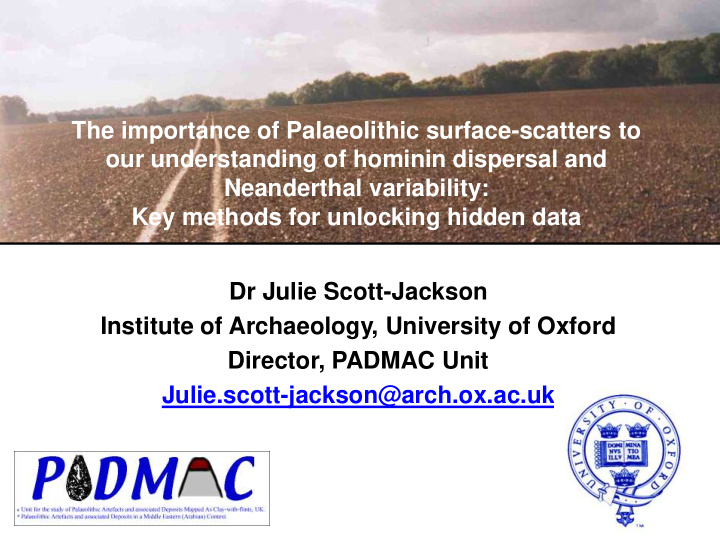



The importance of Palaeolithic surface-scatters to our understanding of hominin dispersal and Neanderthal variability: Key methods for unlocking hidden data Dr Julie Scott-Jackson Institute of Archaeology, University of Oxford Director, PADMAC Unit Julie.scott-jackson@arch.ox.ac.uk
The Palaeolithic Timeline 2
European Lower Palaeolithic dated sites European Middle Palaeolithic dated sites 3
‘Southern Route’ Out of Africa (shown in red) ‘Northern route’ Area of Surface Scatters ‘Southern route’ 4
Palaeolithic surface- scatters along ‘Southern Route’ Out of Africa in Sharjah and Ras Al Khaimah Emirates (UAE) Palaeolithic surface- scatters along ‘Southern route ’ out of Africa 5
Palaeolithic surface-scatter on hilltop in Clay-with-flints area of Southern England 6
Investigating Palaeolithic surface-scatters • Locating • Recording • Analysing http://users.ox.ac.uk/~padmac/index.html 7
Locating Palaeolithic surface-scatters • Palaeolithic hominin dispersal • Behavioural organization • Habitats • Habitat preferences • Resource provision http://users.ox.ac.uk/~padmac/index.html 8
Project Database for DFY03 Hampshire UK (Mapinfo) Basic GIS mapping Previous Investigations & find-spots Geology 9 Historical mapping (e.g. 1874 hedge-line)
Google mapping showing DFY03 Palaeolithic surface-scatters (shown as white circles) Google mapping (3D) 10
Digital Terrain Modeling for DFY03 Palaeolithic surface-scatters (showing ‘draped’ geology) Data extracted from SRTM90 Satellite Data 11
Aerial Photograph for DFY03 Palaeolithic surface-scatters (showing Iron-Age hill-fort ditch) 12
Field-investigations: Aims and techniques for recording Palaeolithic surface-scatters. http://users.ox.ac.uk/~padmac/index.html 13
Palaeolithic Survey Grid for Qatar (with unique grid square identifiers) Allows: • co-ordination of Palaeolithic field investigations, • Recording of presence and absence of Palaeolithic evidence • Retention and access to all information generated 14
Palaeolithic Research Agendas Scott-Jackson, JE, 2001, Avebury World Heritage Site Research Agenda; Scott-Jackson, JE & Scott-Jackson WB 2010a, Palaeolithic Research Agenda for the State of Qatar 15
Field Investigations using GPS Tracking Qatar 2010 Google Earth and MotionX tracking and navigation software 16
Detailed Digital Terrain Model for Palaeolithic surface-scatters ESF06/7 (United Arab Emirates) 17
Close Range Aerial Photography using dirigible for Palaeolithic surface-scatter ESF06A (United Arab Emirates) Area of ESF06A N N Aerial photograph (from tethered dirigible) Photograph from west of site 18
Photogrammetry of area of Palaeolithic surface-scatter (United Arab Emirates)
Results of deep Resistivity Analysis for Palaeolithic surface-scatter DFY03 UK Lines 4/3 concantenated Ditch? 20
Geophysical Investigations of Palaeolithic surface- scatters (DFY03 UK) Magnetometry results showing Iron-Age hill-fort ditch Magnetic susceptibility results showing distinct agricultural regimes across previously split field 21
Aims and techniques for off-site analysis of data from Palaeolithic surface-scatters http://users.ox.ac.uk/~padmac/index.html 22
Inter-Scatter analysis of relationships between Palaeolithic surface-scatters in the locality of DFY03 UK 23 23
Intra-scatter analysis using Photogrammetry for Palaeolithic surface-scatter ESF06A (United Arab Emirates) Plan View Width of site Profile (length of site) Orientation of A-Axis (using Oriana software) 24
Intra-site techno-typological analysis for Palaeolithic surface-scatters ESF06A (United Arab Emirates) (Statistical analysis and refits) Small biface made on a flake with hard hammer retouch. Moderate brown 5YR 4/4. 42x34x15 mm Flake #3 refitted onto core #8 debitage core tool chip chunk Total Count % Count % Count % Count % Count % Count ERM07A Artif act Class 23 30.7% 2 2.7% 49 65.3% 1 1.3% 75 ESF06A Artif act Class 19 40.4% 1 2.1% 27 57.4% 47 ESF06 (slope) Artif act Class 17 54.8% 1 3.2% 13 41.9% 31 ESF07F Artif act Class 35 58.3% 10 16.7% 12 20.0% 3 5.0% 60 ESF06C Artif act Class 5 41.7% 7 58.3% 12 ESF06C Artif act Class 1 8.3% 11 91.7% 12 ESF06D Artif act Class 9 36.0% 2 8.0% 9 36.0% 5 20.0% 25 ESF07E Artif act Class 20 35.7% 15 26.8% 5 8.9% 11 19.6% 5 8.9% 56 ESF07S10 Artif act Class 16 35.6% 2 4.4% 25 55.6% 2 4.4% 45 ESF07S14 Artif act Class 6 33.3% 3 16.7% 7 38.9% 2 11.1% 18 ESF07S15 Artif act Class 2 18.2% 3 27.3% 4 36.4% 1 9.1% 1 9.1% 11 ESF07S18 Artif act Class 1 50.0% 1 50.0% 2 Gabbro Hill Artif act Class 4 23.5% 6 35.3% 6 35.3% 1 5.9% 17 Misc UAE Artif act Class 1 10.0% 4 40.0% 5 50.0% 10 25
Group A3 Surface Find Inter-site techno-typological analysis Assemblage of Palaeolithic surface-scatters ESF06/7 (United Arab Emirates) and the excavated assemblage at Jebel Faya (United Arab Emirates) Jebel Faya Assemblage C Backed Foliates bifaces Unipolar cores (o,q) Levallois blanks (a,e) Centripetal Levallois Retouched points (b,d) 1, bifacial foliate; cores/discoids (p,r,s) Unipolar Levallois cores (c,f) 2, Levallois flake; 3, bifacial preform; 4, radial core; 5, handaxe preform. Scott-Jackson, J.E., Scott-Jackson, W.B. Rose, J.I. Palaeolithic Stone Tool Assemblages from Sharjah and Armitage, S.J., et al., The Southern Route “Out of Africa”: Ras al Khaimah in the United Arab Emirates. In: Petraglia, Evidence for an Early Expansion of Modern Humans into M, Rose, J. editors. The Evolution of Human Populations in Arabia. Science , 2011. 331(28): p. 453-456 Arabia. Springer, Netherlands. 2009: 125-138. 26
Dr Julie Scott-Jackson, Director, PADMAC Unit Dr William Scott-Jackson, PADMAC Unit University of Oxford Email:- julie.scott-jackson@arch.ox.ac.uk 27
Recommend
More recommend